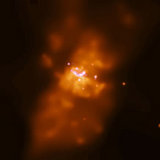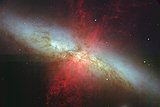Galactic Winds
Galactic winds are streams of high speed charged particles often observed blowing out of galaxies. With speeds of between 300 and 3,000 km/sec, these winds can either blow material out into the halo of the galaxy, possibly to mix with the hot X-ray emitting halo gas, or expel the matter from the galaxy completely to mix with the intergalactic medium. Galactic winds have two sources of energy: starbursts and active galactic nuclei (i.e. the supermassive black holes lurking in the centres of most galaxies).
In the case of starbursts, galactic winds are powered by high speed stellar winds ejected from newly formed massive stars (similar to the solar wind, only far more dense and energetic), and supernova explosions.
| For example, the starburst galaxy, M82, is undergoing a massive burst of star formation. The bright points of light in the image are newly formed massive stars which are ejecting masses of material in the form of a stellar wind. At the end of their lives, these stars will explode in core-collapse supernova explosions which will eject even more stellar material into the interstellar medium. The enormous amounts of energy from the stellar winds and supernova explosions of these massive stars has created a galactic wind which is evident as an orange haze in this Chandra X-ray image. |
| An idea of the extent and orientation of the galactic wind of M82 is seen in this image, which traces the ionised hydrogen (red) contained within it. The wind extends ~10,000 light years from the centre of the galaxy where the starbust is taking place. The burst of star formation powering the wind was probably caused by an interaction with the neighbouring galaxy M81 (not shown). |
For active galactic nuclei, galactic winds are powered by the supermassive black hole resident at their centre. If the black hole is accreting a significant quantity of matter (i.e. is ‘active’), the combined energy output of the accretion disk and the galactic jets can be sufficient to expel ambient gas from the galaxy in a galactic wind.
For example, the active galactic nucleus of NGC 1068 is shown at X-ray (blue/green) and optical (red) wavelengths. A high speed (3,000 km/sec), high temperature (100,000 Kelvin) wind (blue/green) can be seen to emanate from the vicinity of the central supermassive black hole. This wind is most likely powered by the huge accretion disk of gas (5 million solar masses worth) that extends up to 300 light years from the black hole. The optical emission (red) around the central region is the result of star formation in the inner spiral arms of the galaxy.
Galactic winds are believed to play several important roles in the evolution of galaxies. They are responsible for redistributing metals throughout the galaxy and also regulate star formation. If the galactic wind has blown all of the gas out of the galaxy, star formation will cease. However, it is possible that in the long-term, this gas will cool and fall back onto the galaxy, providing a source of gas for future star formation.
Study Astronomy Online at Swinburne University
All material is © Swinburne University of Technology except where indicated.




